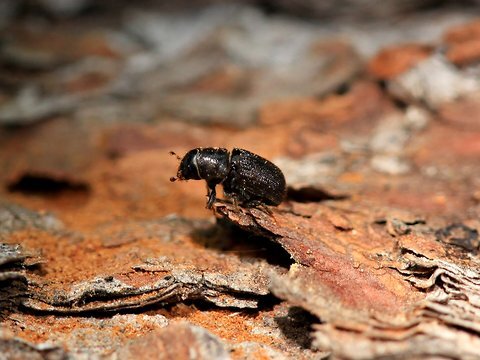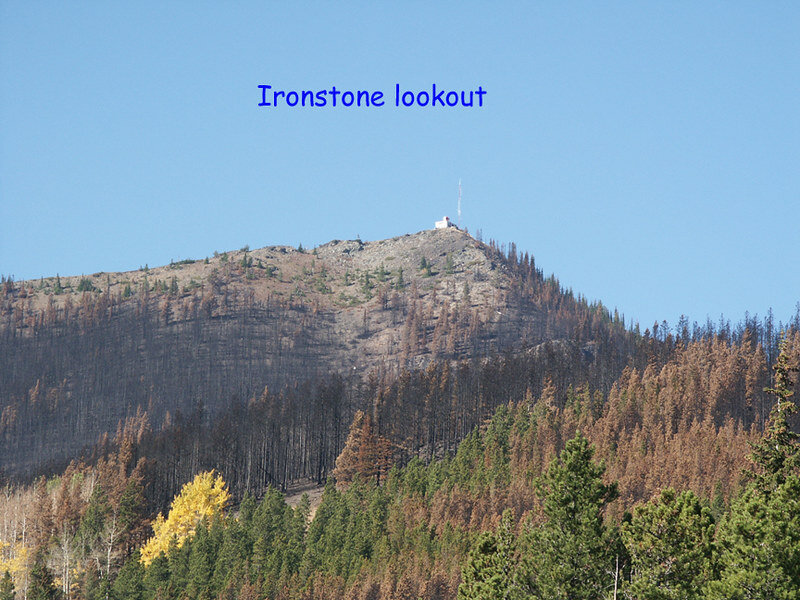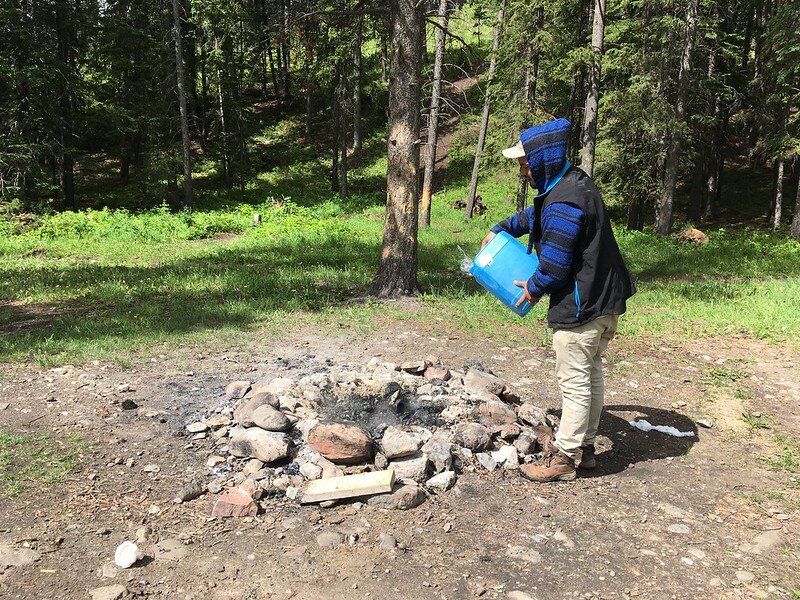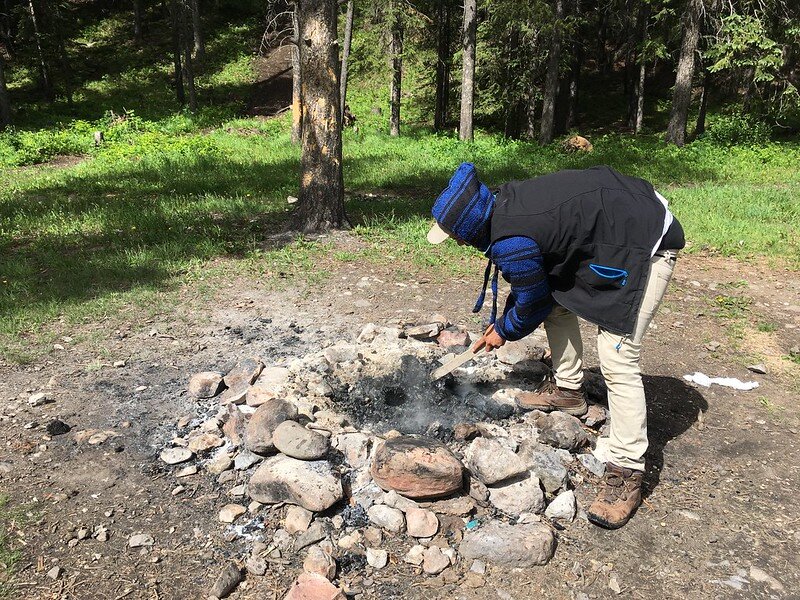by Outreach Assistant Jessica Tinholt
On August 30, 2017, a bolt of lightning started a small wildfire just 10 km away from the boundary of Waterton Lakes National Park, the southwestern tip of our watershed. Unusually hot and dry conditions coupled with strong winds turned this routine fire into one of the most extreme wildfires in our watershed’s recent history: The Kenow Fire. By September 8, 2017, the Waterton Townsite had been evacuated.
In total, 38% of the park (~19,303 hectares) was burned. It took 148 wildland firefighters and 11 helicopters to put out the fire. The fire also destroyed infrastructure such as the Visitor Centre. However, there were thankfully no casualties.
Area burned in the 2017 Kenow Fire. Photo: Parks Canada.
The Kenow Fire is a recent reminder of how powerful wildfires can be. Our watershed and province have seen their fair share of out-of-control wildfires, such as the Lost Creek fire in 2003, and across the province, the Fort McMurray fire in 2016. This year, in 2021, we breathe the smoke from over a thousand fires that have started in British Columbia since April.
Lost Creek fire in 2003. Photo by RJ Pisko.
So, why are we seeing these extreme fires? The truth is that there are a number of cumulative effects, and not just one solution. Historic fire suppression, climate change, and mountain pine beetle infestations are just some of the factors responsible for the extreme fire behavior we’ve seen over the past few years. However, fire isn’t always negative. It leads to regrowth and is vital to the health of our forests. Let’s look at how our opinions on wildfire have changed over the years.
Historic Fire Suppression
Smokey Bear poster from 1949.
Only you can prevent forest fires! Yes, you’ve probably heard that before. Smokey Bear is a well-known figure in North America that has been around since 1944, and he is one of the first examples of campaigning to prevent wildfires. Alberta has a similar character, Bertie Beaver, also meant to spread awareness about preventing wildfire. Messaging about wildfires has been around for decades, and most people are aware of the dangers of forest fires. However, what these older campaigns failed to do was also educate the public on the importance of wildfire in the ecosystem. It was often referred to as a “shameful waste” and “madness”, creating the impression that wildfires were only negative. This is partly because our understanding of wildfire was limited at the time—but not anymore. These days, we have the science to support better management practices, and understand that wildfire benefits the forest as a whole.
Due in part to historical policies that were based on a limited understanding of wildfire, our current forest managers are now in the hot seat. Years of fire suppression have led to years of fuel build-up: excess trees, deadfall, and other forest litter have turned some forests into a match box. This means that a fire might become out of control far quicker if lit, and thus far more dangerous.
2017 Kenow Wildfire. Photo by Ryan Peruniak, © Parks Canada
Another contributing factor to extreme fire behavior is the mountain pine beetle. The mountain pine beetle is a tiny invader plaguing forests in Alberta and British Columbia, killing entire stands of trees and leaving them dead and dry. Warmer winters, as a result of climate change, have led to fewer pine beetles dying because they are not exposed to extreme temperatures for long enough. This makes outbreaks more severe, and leaves more dead trees as perfect tinder for a raging wildfire.
Mountain Pine Beetle attack the canopy, creating the red stage seen here from atop the Kennedy Siding Flux Tower in Interior British Columbia. Photo credit: Matthew Brown, UBC, via Flickr.
The mountain pine beetle chomps away on a tree in the southern Rockies. Photo credit: Jeffry B. Mitton.
Wildfire Technology Today
There is an ongoing solution to combat fire suppression: prescribed burns. Prescribed burns are fires set in a specific area under beneficial conditions that allows the area to be burned in a safe and controlled manner. By removing the available fuel (trees, grasses, woody debris, etc) in several smaller areas, you greatly decrease the risk of a major fire later down the line that is hard to control and a risk to life and property. Agriculture and Forestry work with stakeholders to identify areas where a prescribed fire may be beneficial, and sites are carefully selected by fire management staff.
Prescribed fire ignition by drip torch. Photo credit: Alberta Wildfire.
Alberta maintains a regime of staff and equipment designed for fighting wildfire throughout the fire season (spring to autumn). A major part of a successful fire season is prevention, but when that isn’t possible, it is vital that wildland firefighters get an early start on flare-ups. They do this through fire lookout towers. There are 127 fire lookout towers located throughout the province, and they are responsible for the early detection of forest fires in their area. Moreover, these towers provide consistent and accurate weather updates to predict fire behavior and provide information to the general public.
Ironstone Fire Lookout. Photo credit: RJ Pisko.
Fire in the Oldman Watershed
If you’ve been to Waterton Lakes National Park recently, the effects of the Kenow Fire are still clearly seen. However, there is something magical happening amidst the scarred landscape: regrowth. As residents of the Oldman watershed, we get to see succession (the process of regrowth in an ecological community following disturbance) happen before our eyes.
Fireweed, a flower that dominates after wildfires in many western landscapes, is seen here 10 years after the 2006 Gash Creek Fire in western Montana. Photo credit: Philip Higuera. We are starting to see regrowth in Waterton after the 2017 Kenow Fire, too!
Fireweed blooms throughout meadows amongst nutrient- rich soil and plentiful sunlight. Elk and deer no longer cast their antlers and feet on excess woody debris. Dead standing trees become nest sites for birds and small mammals. Wildfire, when done right, is a beautiful thing. It resets the forest and allows for new growth. Some animals, such as the lodgepole pine, depend on fire. Lodgepole pine trees have serotinous cones that require extreme heat to open and allow seeds to spread. Wildfire is required for them to regenerate.
Comparison of pictures taken on Sept. 11, 2017 vs. Google Map images Images from MD of Taber Fire Department From @Rodleland (Twitter) WATERTON.
Conclusion
Fire management is a tricky business. On one hand, you have to look after the current forest and ecosystem while still protecting people and their homes. These principles are especially important in parks and protected areas, where heavily-wooded forests ready for a fire back right into populated townsites (such as Banff or, in our watershed, Waterton and Crowsnest Pass). But fire is a natural part of the ecosystem, and management has improved exponentially over the past few decades when it comes to forest management. Looking to the future, recognizing the inevitability of wildfire and adapting our management practices accordingly will be necessary to coexist.
2003 Lost Creek Fire looming over the town of Blairmore, Crowsnest Pass. Photo by RJ Pisko.
But it’s true: you can prevent forest fires! We all have a part to play when it comes to fire prevention and responsible recreation. Leave the fire management to the professionals by maintaining a spark arrestor on your quad, properly disposing of lit cigarettes, and completely extinguishing your campfire before leaving your campsite. Remember to soak, stir it, and soak it again! Finally, be sure to follow local fire bans and restrictions (click on About > Frequently Asked Questions on the menu bar to find out the difference between a fire advisory, fire restriction, fire ban and a forest area closure!).


















